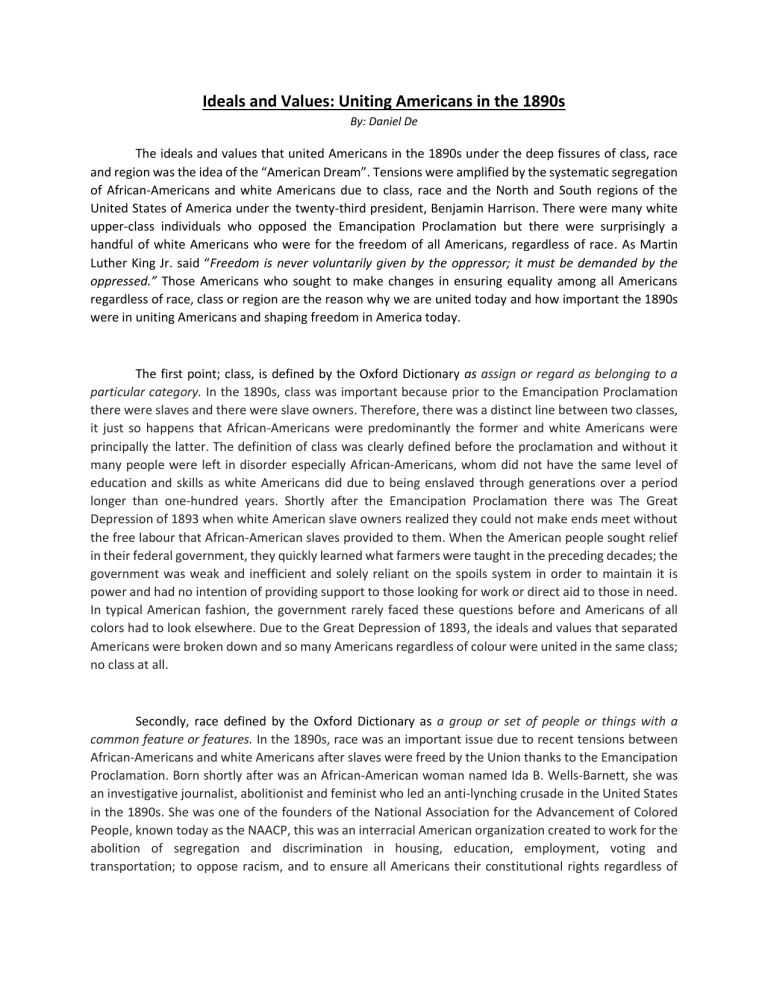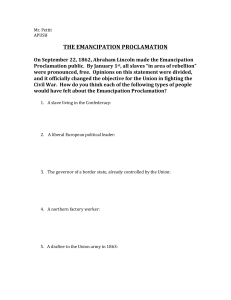
Ideals and Values: Uniting Americans in the 1890s By: Daniel De The ideals and values that united Americans in the 1890s under the deep fissures of class, race and region was the idea of the “American Dream”. Tensions were amplified by the systematic segregation of African-Americans and white Americans due to class, race and the North and South regions of the United States of America under the twenty-third president, Benjamin Harrison. There were many white upper-class individuals who opposed the Emancipation Proclamation but there were surprisingly a handful of white Americans who were for the freedom of all Americans, regardless of race. As Martin Luther King Jr. said “Freedom is never voluntarily given by the oppressor; it must be demanded by the oppressed.” Those Americans who sought to make changes in ensuring equality among all Americans regardless of race, class or region are the reason why we are united today and how important the 1890s were in uniting Americans and shaping freedom in America today. The first point; class, is defined by the Oxford Dictionary as assign or regard as belonging to a particular category. In the 1890s, class was important because prior to the Emancipation Proclamation there were slaves and there were slave owners. Therefore, there was a distinct line between two classes, it just so happens that African-Americans were predominantly the former and white Americans were principally the latter. The definition of class was clearly defined before the proclamation and without it many people were left in disorder especially African-Americans, whom did not have the same level of education and skills as white Americans did due to being enslaved through generations over a period longer than one-hundred years. Shortly after the Emancipation Proclamation there was The Great Depression of 1893 when white American slave owners realized they could not make ends meet without the free labour that African-American slaves provided to them. When the American people sought relief in their federal government, they quickly learned what farmers were taught in the preceding decades; the government was weak and inefficient and solely reliant on the spoils system in order to maintain it is power and had no intention of providing support to those looking for work or direct aid to those in need. In typical American fashion, the government rarely faced these questions before and Americans of all colors had to look elsewhere. Due to the Great Depression of 1893, the ideals and values that separated Americans were broken down and so many Americans regardless of colour were united in the same class; no class at all. Secondly, race defined by the Oxford Dictionary as a group or set of people or things with a common feature or features. In the 1890s, race was an important issue due to recent tensions between African-Americans and white Americans after slaves were freed by the Union thanks to the Emancipation Proclamation. Born shortly after was an African-American woman named Ida B. Wells-Barnett, she was an investigative journalist, abolitionist and feminist who led an anti-lynching crusade in the United States in the 1890s. She was one of the founders of the National Association for the Advancement of Colored People, known today as the NAACP, this was an interracial American organization created to work for the abolition of segregation and discrimination in housing, education, employment, voting and transportation; to oppose racism, and to ensure all Americans their constitutional rights regardless of their race. Therefore, the NAACP was critical in establishing the ideals and values that united Americans in the 1890s despite the deep fissures of race. Finally, region defined by defined by the Oxford Dictionary an area or division, especially part of a country or the world having definable characteristics but not always fixed boundaries. Region in the 1890s was separated by the Northern and Southern states, hence, region was important because between the end of the Civil War and the beginning of the Great Depression nearly two million African-Americans fled the South to seek new opportunities elsewhere. The destination cities for these African-Americans were New York, Chicago, Philadelphia, St. Louis, Detroit, Pittsburgh, Cleveland and Indianapolis. The total population of these eight cities accounted for over two-thirds of the total population of the AfricanAmerican migration. African-Americans were attracted to these cities for a variety of reasons, which included job opportunities, so they could earn a wage rather than be a slave, and even the chance to vote (for men, at least), allegedly free from the threat of violence. Many of these Americans did not have the financial ability to move themselves north so factory owners and other business that sought cheap labor assisted the Great Migration, therefore, uniting the value and ideals of Americans in the 1890s. In conclusion, the ideals and values that united Americans in the 1890s under the deep fissures of class, race and region there are many examples that united Americans. Regardless of class, race and region there was opportunity for all after the Emancipation Proclamation, slaves were freed from the tyranny of the previous years, the idea of class was destroyed due to the Great Depression of 1893 and regions changed because of the new opportunities that the Northern states provided for all. Despite there still being challenges since then, we can see how the 1890s united American values and ideals and ultimately American life as we know it today. The people who gave their lives during the Civil War and those who endured decades of slavery to those who sought to make changes in ensuring equality among all Americans regardless of race, class or region are the reasons why we are united today. As Martin Luther King, Jr. said “The ultimate measure of a man is not where he stands in moments of comfort and convenience, but where he stands at times of challenge and controversy.” This is what a handful of Americans did in the 1890s, they stood up to the challenges and controversies that divided Americans and united them with theses ideals and values to shape America today.


